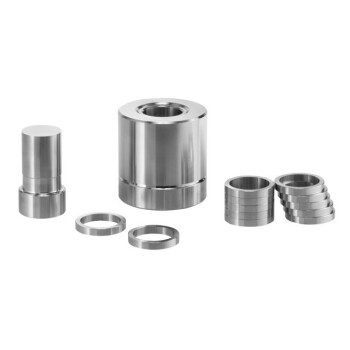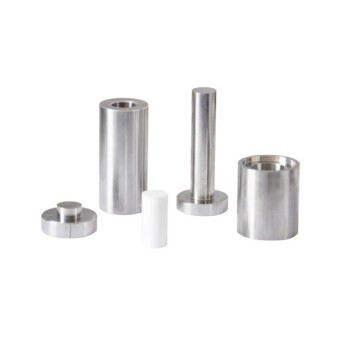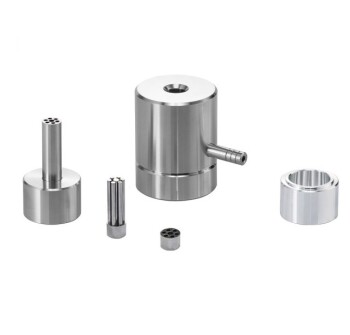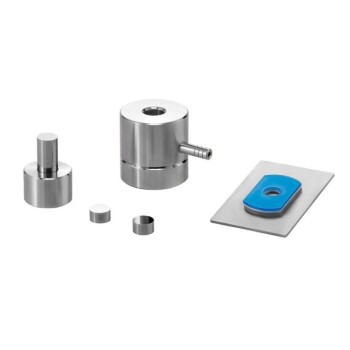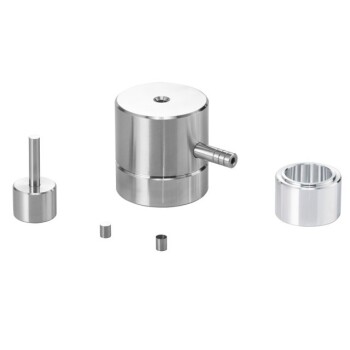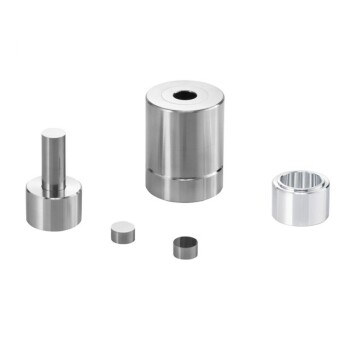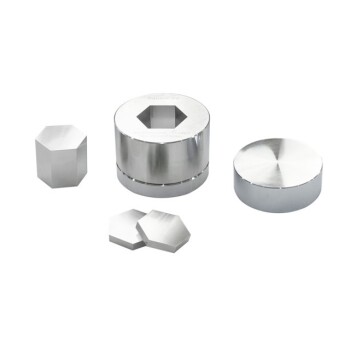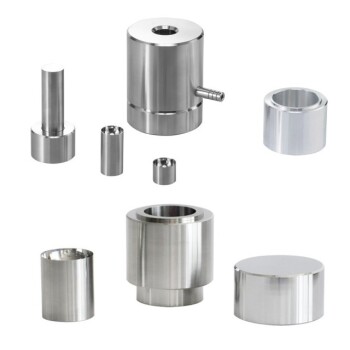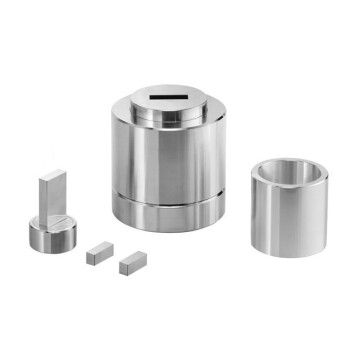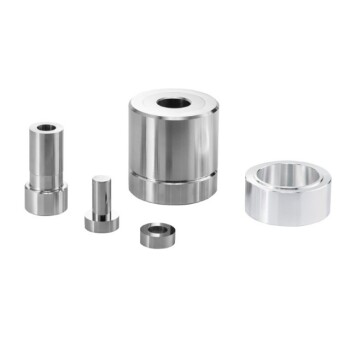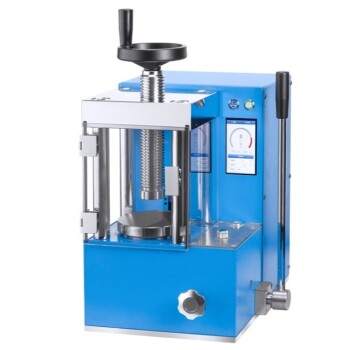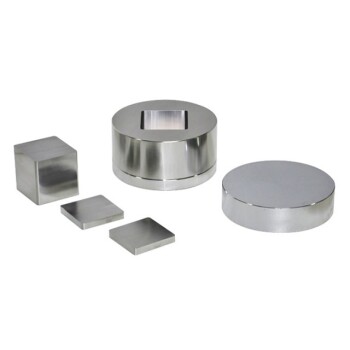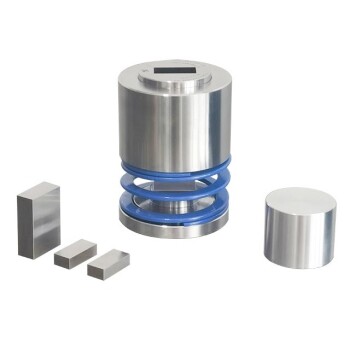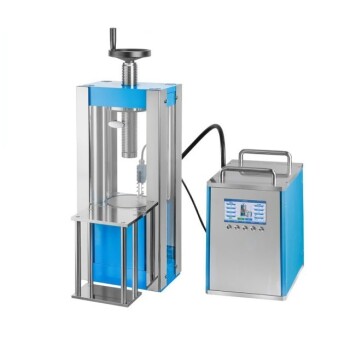For laboratory presses, the most common and essential accessory used for powder compaction is the pellet die. This tool is specifically designed to contain a powdered sample and, under the force of the press, form it into a solid, uniform disk or "pellet" suitable for analysis or further use.
The laboratory press provides the force, but the pellet die provides the form. It is the critical component that transforms loose powder into a consistent, solid sample, which is often a prerequisite for obtaining reliable analytical data.
The Role of the Pellet Die in Sample Preparation
To understand why this tool is so fundamental, we must look at the goal of powder compaction: creating a uniform, solid sample from a loose material.
What is a Pellet Die?
A pellet die is a high-precision mold, typically consisting of a few key parts. It is almost always machined from hardened steel to withstand immense pressure.
The core components include a hollow cylindrical body, a solid base (or anvil), and one or two plungers that fit perfectly inside the cylinder. The powder is loaded into the body, and the plungers are used to compress it.
The Compaction Process Explained
The process is straightforward but requires care. First, the powder is carefully weighed and loaded into the die body.
The plunger is then inserted, and the entire assembly is placed in the laboratory press. As the press applies a load, the plunger compacts the powder against the base, forcing the particles together and removing air voids. After a set pressure is reached, the force is released, and the solid pellet is carefully ejected from the die.
Why Pellet Consistency is Critical
The primary reason for creating these pellets is for analytical techniques, most notably in spectroscopy.
For methods like FTIR (Fourier Transform Infrared Spectroscopy) or XRF (X-Ray Fluorescence), a sample with a smooth surface and uniform density is essential. An inconsistent or crumbly sample can scatter the analytical beam, leading to inaccurate and non-reproducible results. The pellet die is the tool that ensures this consistency.
Understanding the Trade-offs and Common Pitfalls
While a pellet die is a simple tool, using it correctly is critical for safety and data quality. Several factors must be considered.
Material Contamination
Because dies are used for multiple samples, improper cleaning is a major source of cross-contamination. Any residue from a previous sample can compromise the integrity of the next analysis. A strict cleaning protocol between uses is non-negotiable.
Pressure and Die Integrity
Pellet dies are rated for a maximum pressure. Exceeding this limit can cause catastrophic failure, where the hardened steel can shatter, posing a significant safety hazard. Always operate within the manufacturer's specified limits.
Sample and Die Material Compatibility
Some materials can react with or adhere to the steel of the die. In specialized cases, die sets made from other materials may be required. Furthermore, highly abrasive powders can wear down the die's polished internal surfaces over time, affecting pellet quality.
Making the Right Choice for Your Goal
Your choice of tooling depends entirely on your final application. While the pellet die is the standard for powders, other options exist for different tasks.
- If your primary focus is routine powder analysis (like FTIR): A standard cylindrical pellet die is the workhorse tool you need to create KBr or other sample pellets.
- If your primary focus is creating thin polymer films: You will need a press equipped with heated platens, which melt and form the material under pressure.
- If your primary focus is material strength testing: You may require specialized bending or forming jigs in place of a pellet die to test a material's mechanical properties.
Ultimately, selecting the right accessory for your laboratory press is the first step toward ensuring the quality and reliability of your results.
Summary Table:
| Aspect | Details |
|---|---|
| Primary Accessory | Pellet Die |
| Function | Forms powder into solid, uniform pellets for analysis |
| Key Components | Cylindrical body, base, plungers |
| Material | Hardened steel (resistant to high pressure) |
| Common Uses | FTIR, XRF spectroscopy |
| Critical Factors | Pressure limits, cleaning to avoid contamination, material compatibility |
Upgrade your lab's sample preparation with KINTEK's precision pellet dies! Our automatic lab presses, isostatic presses, and heated lab presses are designed to deliver consistent, high-quality pellets for accurate FTIR and XRF analysis. Avoid contamination and ensure reliable results with our durable, easy-to-use accessories. Contact us today to discuss how we can meet your laboratory needs and enhance your efficiency!
Related Products
- XRF KBR Plastic Ring Lab Powder Pellet Pressing Mold for FTIR
- XRF KBR Steel Ring Lab Powder Pellet Pressing Mold for FTIR
- Lab XRF Boric Acid Powder Pellet Pressing Mold for Laboratory Use
- Lab Cylindrical Press Mold with Scale
- Assemble Lab Cylindrical Press Mold for Laboratory Use
People Also Ask
- How is the pellet released from the die after pressing? Master the Safe Ejection Process
- What maintenance practices are recommended for a KBr Pellet Press? Ensure Reliable FTIR Spectroscopy Results
- What are the characteristics of an ideal powder for XRF pellet pressing? Achieve Reliable Analysis with Fine, Uniform Particles
- What are the benefits of using pellet presses for FTIR analysis? Achieve Superior Spectral Quality and Reproducibility
- How does a pellet press contribute to FTIR sample preparation? Achieve Precise and Reliable Spectroscopy Results

